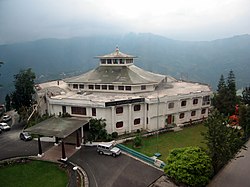Sikkim Legislative Assembly
Sikkim Legislative Assembly | |
|---|---|
| 11th Sikkim Assembly | |
 | |
| Type | |
| Type | |
Term limits | 5 years |
| History | |
| Preceded by | Sikkim State Council |
| Leadership | |
Deputy Speaker | |
Leader of the House (Chief Minister) | |
| Structure | |
| Seats | 32 |
 | |
Political groups | Government (30)
Vacant (2)
|
| Elections | |
| First past the post | |
Last election | 19 April 2024 |
Next election | 2029 |
| Meeting place | |
 | |
| Sikkim Legislative Assembly, Gangtok, Sikkim, India | |
| Website | |
| Sikkim Legislative Assembly | |
The Sikkim Legislative Assembly is the unicameral state legislature of Sikkim state in north-eastern India. The seat of the Legislative Assembly is at Gangtok, the capital of the Sikkim state.
History
Sikkim became the 22nd state of India by the 36th Amendment of the Indian Constitution in 1975. The Act provides that the Legislative Assembly of Sikkim shall consist of not less than thirty two members and that "the Assembly of Sikkim formed as a result of the elections held in Sikkim in April 1974 with 32 members elected in the said elections (hereinafter referred to as the sitting members) shall be deemed to be the legislative Assembly of the State of Sikkim duly constituted under the Constitution."
Sikkim is situated in the North East of India and has a geographical area of 7,096 square kilometres (2,740 sq mi) and a population of 6.1 lakhs. It was a tiny Himalayan kingdom, ruled by a hereditary monarchy for about 3 centuries from the 17 century CE to 1975. In 1950, the kingdom became a protectorate of the Government of India, and was vested with autonomy in its internal affairs while its defense, communications and external relations became the responsibility of India. The kingdom finally opted to become full-fledged state of the Indian Union with effect from 26 April 1975.
Kazi Lhendup Dorjee was the first Chief Minister of Sikkim state from 1975 to 1979. Nar Bahadur Bhandari and Pawan Kumar Chamling served long terms as Chief Minister. As of the 2019 Sikkim Legislative Assembly election, Prem Singh Tamang is the Chief Minister.[needs update]
Structure

There are 32 members in the legislative assembly.[1] There are 12 seats reserved for BL Community of Sikkim. These scheduled tribes include ethnic tribes such as Bhutia, Lepcha (Sherpa), Limbu, Tamang and other Sikkimese Nepali Communities, as specified during the merger of the Kingdom of Sikkim (monarchy) into India. 2 seats reserved for Scheduled Castes (SC).[2] One seat (Sangha) is reserved for the Buddhist monastic community of Sikkim.[3]
Members of Legislative Assembly
{{#Section-h:11th Sikkim Assembly|Members of Legislative Assembly}}
See also
- List of constituencies of the Sikkim Legislative Assembly
- List of chief ministers of Sikkim
- List of states of India by type of legislature
- Vidhan Sabha
Notes
References
- ^ "Sikkim Legislative Assembly". Archived from the original on 31 March 2012. Retrieved 12 April 2012.
- ^ "Sikkim Assembly polls LIVE: Pawan Chamling's fate hangs in balance as voting begins". Zee news. 12 April 2014. Archived from the original on 12 May 2014. Retrieved 11 May 2014.
- ^ "32-Sangha constituency: Sikkim's intangible seat, where only monks contest and vote". The Hindu. 4 April 2019. Archived from the original on 26 February 2021. Retrieved 3 January 2021.
- Short description with empty Wikidata description
- Use dmy dates from August 2019
- Articles with invalid date parameter in template
- Use Indian English from August 2019
- All Wikipedia articles written in Indian English
- Sikkim Legislative Assembly
- State legislatures of India
- Unicameral legislatures
- Government of Sikkim
- 1975 establishments in Sikkim